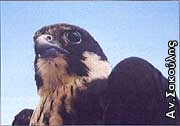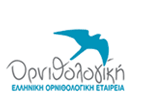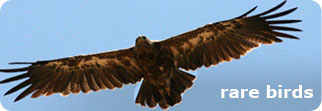 Eleonora's Falcon is a medium sized falcon with characteristic long wings and tail and very skillful flight. Adults occur in two color phases: a dark one, almost black (25% of the population) and another, more usual, light-colored in which the body is light chestnut-red with longitudinal bars.
Eleonora's Falcon is a medium sized falcon with characteristic long wings and tail and very skillful flight. Adults occur in two color phases: a dark one, almost black (25% of the population) and another, more usual, light-colored in which the body is light chestnut-red with longitudinal bars.
In any case, in field conditions even light-colored phase shows a very dark, almost black, bird. Juveniles are more chestnut with many bars. Its gregarious habits and its characteristic voice (a nice, almost childish, "ke-ke-ke-ke") are also important characteristics.
Solitary individuals can be confused with Peregrines, although it is more robust and has shorter tail. Eleonora's Falcons wandering in mainland Greece can be also confused with other falcon species, such as Hobbies.
Eleonora's Falcons winter mainly in Madagascar, returning at April and May. They nest in islets all over the Mediterranean, with an isolated population in the Canaries.
Yet, despite the wide distribution, the overwhelming majority of the population is concentrated in Greece where Eleonora's Falcons nest in several tens of islets all over the Aegean. Few numbers breed in the Ionian, with few colonies around Zante and Corfu. The biggest populations are located in an arch created by Antikythira, eastern Crete, northern Cyclades, north and west Dodecanese, Northern Sporades and Limnos. Last estimation of Greek population, conducted on the ‘70s, shows an average of 2,800 pairs. However, HOS’ research in the Aegean shows that the actual population must be considerably larger. Our country seems to accommodate at least 75% of the world’s population.
Even though it returns in Greece at mid spring, Eleonora's Falcon breeds only at late July. Until then it hunts mainly large insects in the islands or over the sea (like migrating butterflies and moths). At that time, Eleonora's Falcons can be observed in mainland Greece, even in high mountains very far from coast.
Young are hatched at late August, whereas an enormous migration front occurring then provides an easy and abundant food source for young falcons. This, along with the hundreds of safe nesting islets with no people, must be the secret of abundance of Eleonora's Falcon in the Aegean. At early October the young fledge and by the end of the month, all birds have left for Madagascar where they return to their insectivorous diet.
Eleonora's Falcon seems to be the most numerous bird of prey of Greece and it may sound strange that its protection is of great importance. As a matter of fact, all the other birds of prey are widely distributed, while Eleonora's Falcon conservation depends entirely on Greece.
Many Eleonora's Falcons are killed by poachers, while, although fading, there is also the habit of collecting chicks for food (they are said to be delicious with pilaf). The most serious threat, however, derives from the gradual extension of human activities in the desolated islets where the species breeds.
Eleonora's Falcon, as well as seabirds, depends on the isolation of the nesting islands. With tourism extended and superabundance of sails, this asylum is violated. Moreover, hunters are a frequent problem, as the species breeds in autumn. They frequently bring dogs, which are a real disaster for nests and chicks.
Many more interventions are being made in islets, usually without planning or advice from ornithologists. All these are creating a very alarming future. We must urgently realize our responsibility of accommodating more than three quarters of the world population of a species. The only hope, along with other rare species like Audouin’s Gull, is the recognition of the unique value of the Aegean’s islets and the protection of this unique natural treasure of our country.


 Eleonora's Falcon is a medium sized falcon with characteristic long wings and tail and very skillful flight. Adults occur in two color phases: a dark one, almost black (25% of the population) and another, more usual, light-colored in which the body is light chestnut-red with longitudinal bars.
Eleonora's Falcon is a medium sized falcon with characteristic long wings and tail and very skillful flight. Adults occur in two color phases: a dark one, almost black (25% of the population) and another, more usual, light-colored in which the body is light chestnut-red with longitudinal bars.
